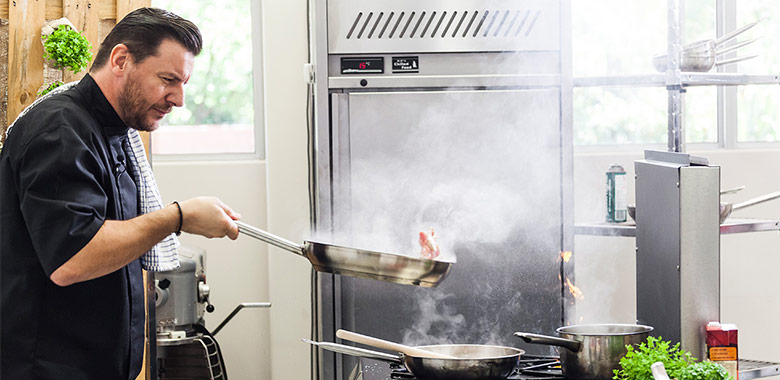
Food
More pork on your fork
One of my favourite scenes in the TV show, The Simpsons, is when Lisa is telling her dad Homer that she is no longer going to eat meat.
“What about bacon?” asks Homer.
“No,” replies Lisa.
“Ham?”
“No.”
“Pork chops?”
“Dad, those all come from the same animal.”
“Heh heh heh. Ooh, yeah, right, Lisa. A wonderful, magical animal.”
It might have been a great punchline on TV, but in reality Homer was pretty spot on. The varied cuts of pork and the vast ways to cook them has seen pork become very popular with Australians. But it hasn’t always been this way. Statistics show that 50 years ago it was beef and lamb that dominated the dinner plate; pork, and chicken for that matter, were barely a blip on the radar.
One of the key reasons why this has changed is also the same reason why we are drinking table wine instead of fortifieds, and that is immigration. Our once predominant English-inspired dinner of meat and three veg has thankfully been complemented by a succulent array of delicious dishes. Think spaghetti Bolognese, pasta carbonara, chorizo paella, char siu – all of which, incidentally, feature pork; and that is not even thinking about breakfast (bacon and eggs) or, for that matter, lunch; ham and salad sandwich, anyone?
Kitchen tradition
Peter Haydon, marketing manager for Australian Pork, says tradition has played a huge role in shaping our food preferences and hindered his job in promoting pork.
“People grow up to cook the meals their parents cooked,” he says “That was steak and veg, lamb chops, roast beef.”
Decades ago Australian Pork had great success with the ‘get some pork on your fork’ campaign – many of you reading this will still have that phrase indelibly inked on your memory, and while that brought attention to the ‘other white meat’, it only did some of the job.
“The next challenge was teaching them how to cook it,” says Peter. For the past decade, Australian Pork have marketed PorkStars – a collection of well-known chefs such as Manu Feildel, Giovanni Pilu, Alessandro Pavoni, Dan Hong, Chui Lee Luk – all of whom have shown Australians how to cook pork via events and recipes.
Manu explains that pork played a huge role in his upbringing in France, learning different cuts and the many ways to prepare them. It is this knowledge that he hopes to pass on through his recipes.
“Food has always played a big part in our lives, my dad was a chef, so was his dad,” says Manu. “One of my uncles is a ‘charcutier’, so he’s an expert with pork and making pork products, such as salamis, pâtès, rillettes, and his own specialities, so pork has always been part of my diet.
“I believe that pork is more versatile than any other animal,” states Manu. “You can eat everything from ‘nose to tail’. Roasts, stews, pan fried, deep fried, confit. Charcuterie, and things you not think about, like intestine for sausage skin, blood for black pudding, head for terrines, trotters, tail, ears, and more.
“Creating recipes with pork is endless and it is a great match with other ingredients. It pairs beautifully with fruits such as apple, prunes, apricots, so as a chef, you can let your imagination run wild.”
The science of eating
Manu is also brand ambassador for Murray Valley Pork, part of the Rivalea group and Australia’s largest pork producer. They sell their extensive range of pork products exclusively through butchers and see the affable chef as a great way to promote their brand and also to continue to educate Australians on how to cook pork.
“Manu’s reputation as an acclaimed chef has been instrumental in growing awareness of the brand,” says Sean Barrett, marketing manager with Murray Valley Pork. “We work together to communicate the same message: the best quality taste and experience when it comes to pork.”
To this end, over the past 15 years Murray Valley Pork have invested heavily in addressing many concerns of consumers, from animal welfare to issues such as dryness, colour and pork taint, to create a better quality product.
“There’s a cultural misconception that pork needs to be served well done, however more consumers are understanding this is not the case,” says Sean, who explains that they use a number of techniques including moisture infusion to ensure their pork doesn’t dry out from cooking.
“It is easy to cook, which means everyone can produce a great result This guarantee of a soft, tender and delicious meal every time significantly increases consumer confidence in cooking pork.”
Well-fed welfare
Dr Rebecca Morrison, animal welfare programs manager at Rivalea, details how the company has also set the benchmark in providing the best care of their stock.
“Rivalea commits to ‘care for every pig, every day’,” she says. “For instance, instead of pregnant sow stalls, our pregnant sows are now housed in social groups. This ensures that the sow is able to move freely within group housing and is able to perform natural social behaviours. More than half of our pigs are reared in straw-bedded housing systems.
“Other programs include loose farrowing systems, group weaning of sows and environmental enrichment for animals. This humane treatment ensures the end product is of the highest quality.”
It is these points that Manu believes will see pork continue to grow in the market and is the reason why he chose to work with the brand.
“Murray Valley Pork produces the highest quality of meat,” he says. “They do this ethically and responsibly. And I love the consistency, sweetness and tenderness across all of their cuts.”
Check out Manu's delicious pork recipes with our wine matching suggestions
Pork, peas and asparagus risotto